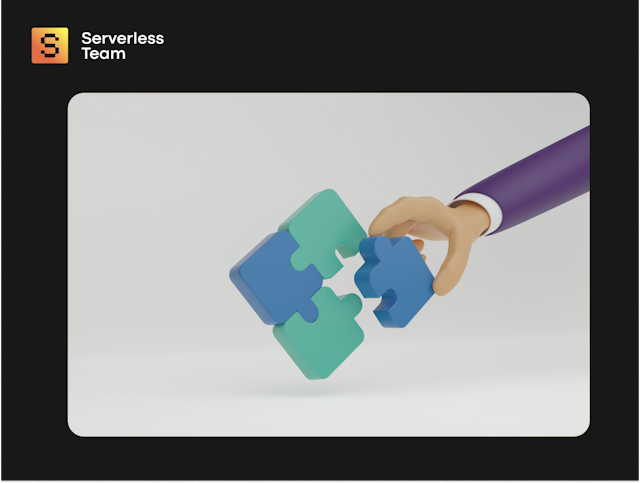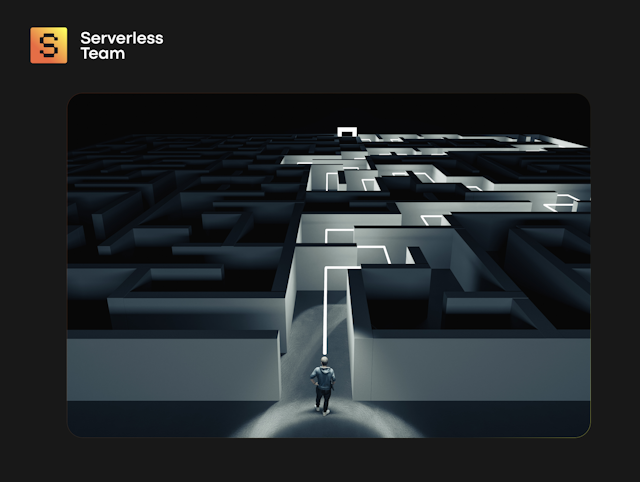If you're navigating the ever-evolving tech sea, you've undoubtedly encountered terms like "cloud-based" and "SaaS" (Software-as-a-Service) more times than a New Yorker hears sirens on a busy day.
But do you know the ropes when distinguishing between these two tech powerhouses? Fear not; we’re about to embark on a comprehensive voyage through the binary skies to uncover the main differences between Cloud-based vs. SaaS-based services.
Before we set sail, let's establish some trust in our journey together. With our rich experience in the digital ocean, we, Serverless, are your seasoned guides to ensure this voyage provides you with practical insights that'll steer your tech ship to success. Rest assured, you're in good hands.
Navigating the Cloudscape
Since the pandemic hit, cloud computing has reigned supreme. It's the force propelling businesses into the future faster than a Tesla going zero to sixty. Why? Because it's akin to the invention of the wheel — a game-changer. The cloud has transformed businesses’ operations, offering unprecedented flexibility, cost-efficiency, and scalability.
It's become the backbone of everything, a toolset capable of making the craziest ideas come true, from streaming services to cutting-edge AI applications.
Now that we’re done with our moment of cloud appreciation, let us explore the key differences between cloud and SaaS-based services.

We take care of serverless development so you can focus on your business
Don't want to wait for our site launch? Let's talk about your idea right now.


Understanding Cloud-Based Services
Cloud-based services are like the virtual apartment complexes of the digital world. They offer resources (servers, storage, databases) over the internet, allowing users to scale up or down as if they were resizing a Super Mario character.
In this section, we'll delve into the core concepts of cloud-based services, highlighting their key characteristics, types, and how they differ from Software as a Service (SaaS) offerings.
Definition of Cloud-Based Services
Cloud-based services, often called cloud computing, entail the delivery of computing resources and services over the internet. Unlike traditional on-premises solutions, cloud-based services remove the need to invest in and maintain physical hardware and software infrastructure.
Instead, these services are hosted and managed by third-party cloud providers in data centers worldwide.
Core Characteristics of Cloud-Based Services
- Scalability: One of the fundamental advantages of cloud-based services is their scalability. Businesses can effortlessly scale up or down their computing resources based on demand, ensuring optimal performance and cost efficiency.
- On-Demand Availability: Cloud services are accessible on-demand, enabling users to access applications, storage, and other resources instantly from anywhere with an internet connection.
- Cost-Efficiency: With cloud-based services, businesses only pay for the resources they consume, eliminating the need for significant upfront investments in infrastructure.
- Flexibility: Cloud services offer a wide range of options, allowing companies to choose the services and configurations that best suit their needs.
- Redundancy and Reliability: Cloud providers maintain redundant data centers, ensuring high availability and data reliability. This minimizes the risk of data loss due to hardware failures or disasters.
Types of Cloud Services
There are several categories of cloud-based services, each serving specific purposes within IT infrastructure and software delivery:
- Infrastructure as a Service (IaaS): IaaS provides virtualized computing resources over the internet. It includes services like virtual machines, storage, and networking. Users have complete control over the infrastructure, while the cloud provider handles the underlying hardware.
- Platform as a Service (PaaS): PaaS offers a platform that allows developers to build, deploy, and manage applications without worrying about the underlying infrastructure. It provides tools and services for application development, such as databases, development frameworks, and application hosting.
- Software as a Service (SaaS): SaaS is a software delivery model where applications are hosted in the cloud and made available to users on a subscription basis. Users can access the software through a web browser, eliminating the need for local installations.
- Function as a Service (FaaS): FaaS, also known as serverless computing, enables developers to run individual functions or code in response to events. It abstracts server management, allowing developers to focus solely on writing code.
Distinguishing Cloud-Based Services from SaaS
It's essential to differentiate cloud-based services from SaaS, as they are related but not synonymous:
- Cloud-based services encompass a broader spectrum of computing resources and infrastructure, including IaaS, PaaS, and SaaS.
- SaaS, on the other hand, is a subset of cloud-based services that refers explicitly to software applications delivered over the internet. SaaS applications are ready-made and accessible through web browsers.
Cloud-based services offer a dynamic, cost-effective, and scalable approach to managing IT resources and software delivery. Understanding the core characteristics and different types of cloud services is pivotal in making informed decisions about adopting cloud-based solutions and distinguishing them from SaaS offerings.
In the following sections, we will explore the world of SaaS-based services, drawing comparisons and distinctions between these two cloud-based paradigms.

Kyrylo Kozak
CEO, Co-founderGet your project estimation!

Exploring Software-as-a-Service (SaaS)
Among other cloud-based services, Software-as-a-Service (SaaS) stands out as a revolutionary approach to software delivery and application access. This section is dedicated to understanding SaaS, its defining characteristics, and how it differentiates itself from other cloud services models, such as Infrastructure as a Service (IaaS) and Platform as a Service (PaaS).
Definition of Software-as-a-Service (SaaS)
Software-as-a-Service (SaaS) is a cloud computing model that provides users access to hosted software applications in the cloud. Instead of installing and maintaining software on individual devices or servers, users can access these applications through web browsers on a subscription basis.
SaaS applications are typically centrally hosted and managed by third-party providers, eliminating the need for users to handle software installations, updates, and maintenance.
Key Attributes of SaaS
- Subscription Model: SaaS applications are offered on a subscription basis, allowing users to pay for software access over a specific period, often monthly or annually. This subscription model offers cost predictability and flexibility.
- Automatic Updates: SaaS providers are responsible for continuously maintaining and updating the software. This ensures that users always have access to the latest features, security patches, and improvements without manual intervention.
- Accessibility: SaaS applications are accessible from any device with an internet connection and a web browser, allowing users to work from various locations and devices.
- Scalability: SaaS offerings can easily scale up or down based on user needs. Organizations can adjust the number of user licenses or resource allocation to accommodate changing requirements.
- Multi-Tenancy: SaaS providers often follow a multi-tenant architecture, where multiple users or organizations share the same instance of the software while maintaining data isolation and security.
Differentiating SaaS from Other Cloud Service Models
It's essential to distinguish SaaS from other cloud service models, such as IaaS and PaaS, and especially SaaS versus cloud computing.
- SaaS vs. IaaS: While SaaS focuses on software delivery, Infrastructure as a Service (IaaS) provides virtualized computing resources like virtual machines, storage, and networking. Users of IaaS have more control over their infrastructure but are responsible for managing the software stack.
- SaaS vs. PaaS: Platform as a Service (PaaS) offers a platform for application development, including tools, frameworks, and hosting environments. Unlike SaaS, PaaS users are responsible for developing and deploying their applications.
- SaaS vs. Cloud: The term "cloud" is an umbrella concept that encompasses various cloud service models, including SaaS. Cloud-based services refer to the broader range of services, while SaaS specifically addresses software delivery over the internet.
Advantages of SaaS
- Cost-Efficiency: SaaS eliminates the need for organizations to invest in on-premises hardware and software, reducing upfront costs and ongoing maintenance expenses.
- Accessibility and Collaboration: SaaS applications promote collaboration by enabling remote and real-time access to software, fostering teamwork among geographically dispersed teams.
- Automatic Updates: Users benefit from continuous software updates and improvements without the burden of manual installations and patches.
- Scalability: SaaS scales effortlessly to accommodate growing user bases or changing resource requirements.
- Focus on Core Competencies: By outsourcing software management to SaaS providers, organizations can focus on their core competencies and strategic initiatives.
Challenges of SaaS
- Data Security: Storing data in the cloud raises concerns about data security and privacy, although SaaS providers typically implement robust security measures.
- Internet Dependency: SaaS applications rely on internet connectivity, which can be a limitation in areas with unreliable or limited internet access.
- Limited Customization: While SaaS applications offer flexibility, extensive customization may be limited compared to on-premises solutions.
Software-as-a-service (SaaS) is a groundbreaking approach to accessing and delivering software via the cloud. It offers numerous advantages, including cost-efficiency, automatic updates, and unmatched accessibility. For businesses in search of the perfect cloud solution, understanding how SaaS distinguishes itself from other cloud service models is essential.
Key Differences Between Cloud and SaaS
While both operate within the cloud computing realm, they have distinctive characteristics that set them apart. Understanding these differences between cloud-based and SaaS-based services is crucial for making informed decisions about which model best suits your needs.
Service Scope
Cloud-Based Services: These encompass a broad spectrum of cloud offerings, including Infrastructure-as-a-Service (IaaS), Platform-as-a-Service (PaaS), and more. They provide a comprehensive cloud environment where users have greater control over configurations and can run various applications.
SaaS: SaaS is a subset of cloud-based services focused exclusively on delivering software applications over the internet. Users access software hosted and managed by a third-party provider without needing to manage underlying infrastructure or worry about software updates.
Customization and Control
Cloud-Based Services: Offer greater flexibility and customization options. Users have control over configuring virtual machines, operating systems, and applications according to their specific requirements.
SaaS: Typically, SaaS solutions are less customizable. They are designed to be user-friendly and operate "as-is" with limited room for customization. This simplicity is ideal for users who want to avoid the complexities of software management.
Maintenance Responsibility
Cloud-Based Services: Users are responsible for managing and maintaining the software and infrastructure they deploy. This includes installing updates, managing security patches, and ensuring system uptime.
SaaS: SaaS providers take on the responsibility of software maintenance and updates. Users can focus solely on using the software, freeing them from maintenance tasks.
Scalability
Cloud-Based Services: Offer flexible scalability options. Users can scale resources up or down based on demand, making them suitable for a wide range of applications, including those with fluctuating workloads.
SaaS: Scalability in SaaS is often predefined by the provider. Users can typically add or remove seats or licenses as needed, but they have limited control over the underlying infrastructure's scalability.
Deployment Complexity
Cloud-Based Services: Tend to be more complex to set up and configure, requiring a certain level of IT expertise. They are well-suited for businesses with specific technical requirements.
SaaS: SaaS solutions are designed for ease of use and rapid deployment. They cater to users looking for straightforward access to software without intricate setup processes.
Cost Structure
Cloud-Based Services: Costs can be more variable as they depend on resource usage and configurations. Users pay for the infrastructure and services they use.
SaaS: Often follows a subscription-based pricing model, where users pay a regular fee per user or per usage. This predictability simplifies budgeting but may result in higher costs for some users.
Use Cases
Cloud-Based Services: Suited for a wide range of use cases, including hosting complex applications, managing databases, and developing custom solutions.
SaaS: Ideal for applications where ease of use, accessibility, and rapid deployment are paramount, such as customer relationship management (CRM), email services, and office productivity tools.
Understanding these differences between cloud-based services and SaaS is key to making informed decisions when selecting the most suitable cloud solution for your specific requirements.
We know it’s a lot, and we’re ready to help you with cloud consulting services whenever needed. Whether it's gaining granular control with cloud-based services or enjoying simplicity and convenience with SaaS, the choice ultimately depends on your goals and priorities.
Cloud-based vs. SaaS-based: Similarities
While cloud-based services and Software-as-a-Service (SaaS) differ in various ways, they share several fundamental similarities that make them integral components of the broader cloud-computing landscape. Understanding these commonalities helps clarify the relationship between the two and their role in modern technology solutions.
Cloud Infrastructure
Both cloud-based services and SaaS rely on cloud infrastructure to deliver their offerings. They leverage remote data centers, networks, and servers to provide accessibility and scalability.
Accessibility
Accessibility from virtually anywhere with an internet connection is a hallmark of both models. Users can access cloud-based resources and SaaS applications from various devices, promoting remote work and flexibility.
Resource Pooling
Resource pooling is a core concept shared by both approaches. In a cloud environment, resources like computing power, storage, and databases are pooled and allocated dynamically based on demand. SaaS applications also benefit from resource pooling on the backend, ensuring efficient use of shared infrastructure.
Managed Service
Both cloud-based services and SaaS offer managed services that offload tasks from users or organizations. In the cloud, managed services can include databases, content delivery networks (CDNs), and identity management. SaaS providers manage all aspects of software delivery, from maintenance to updates.
Scalability
Scalability is a shared advantage. Users of cloud-based services and SaaS solutions can scale resources up or down based on their requirements. This scalability helps organizations adapt to changing workloads and user demands efficiently.
Cost-Efficiency
Both models contribute to cost efficiency. Cloud-based services allow users to pay only for the resources they consume, reducing upfront infrastructure costs. SaaS often follows a subscription-based model, providing predictable costs without significant capital investments.
Redundancy and Reliability
Cloud providers, whether offering cloud-based services or SaaS, prioritize redundancy and reliability. Multiple data centers, backup systems, and disaster recovery mechanisms ensure high availability and data integrity.
Global Reach
Cloud-based and SaaS solutions have a global reach, serving users and organizations worldwide. This broad accessibility fosters collaboration, market expansion, and competitiveness on a global scale.
Security Measures
Both models incorporate robust security measures. Cloud providers implement security protocols, encryption, and compliance standards to protect data. SaaS providers similarly prioritize data security, often with features like role-based access control and authentication.
Updates and Maintenance
Users of both cloud-based and SaaS services benefit from automatic updates and maintenance performed by providers. This ensures that software remains up-to-date and secure without user intervention.
Multi-Tenancy
Multi-tenancy, where multiple users or organizations share common infrastructure, is a shared characteristic. Cloud-based services may host multiple users on a single infrastructure, while SaaS applications serve numerous customers on the same software instance.
Service Level Agreements (SLAs)
Cloud providers and SaaS vendors often offer SLAs that define service commitments, including uptime guarantees and support response times. SLAs contribute to trust and accountability in both models.
Focus on User Experience
Both prioritize providing a seamless user experience. Cloud-based services aim to deliver infrastructure and resources efficiently, while SaaS solutions focus on intuitive interfaces and ease of use.
Understanding these similarities between cloud-based services and SaaS clarifies their interconnectedness and underscores their combined impact on modern IT landscapes.
Whether opting for cloud-based infrastructure or adopting SaaS applications, companies benefit from these shared principles to drive innovation, efficiency, and competitiveness of their business.
Cloud-based vs. SaaS-based: Pros and Cons
When looking at SaaS vs. Cloud, weighing their respective advantages and limitations is essential. Below, we summarize both models’ key benefits and drawbacks for a quick comparison.
Cloud-Based Services
| Pros | Cons |
|---|---|
| Scalability and Flexibility | Learning curve for managing resources |
| Cost Efficiency | Responsibility for system management |
| On-Demand Availability | Potential for vendor lock-in |
| Redundancy and Reliability | Network dependency |
| Global Reach | Variable performance |
| Security Measures | Data privacy concerns |
| Managed Services |
Software-as-a-Service (SaaS)
| Pros | Cons |
|---|---|
| Accessibility | Limited customization |
| Automatic Updates | Dependence on vendor roadmap |
| Cost Predictability | Integration challenges |
| Collaboration Tools | Data security and privacy concerns |
| Rapid Deployment | Potential for feature limitations |
| Scalability and Performance | Reliance on internet connectivity |
| Multi-Tenancy |
Keep in mind that the suitability of each model depends on your specific business needs and project requirements. Assessing these pros and cons can guide your decision-making process, ensuring the chosen approach aligns with your goals and resources.
Cloud-Based vs. SaaS-Based: Use Cases and Considerations
To make an informed choice when choosing between cloud-based and Software-as-a-Service (SaaS) solutions, it's essential to consider specific use cases and their associated considerations.
Cloud-Based Services Use Cases
- Infrastructure Flexibility: Cloud-based Infrastructure as a Service (IaaS) is ideal for organizations with fluctuating computing and storage needs. This includes scenarios where businesses require scalable resources for seasonal demands, such as e-commerce websites during holiday seasons.
- Development and Testing Environments: Cloud-based platforms offer a cost-effective solution for creating development and testing environments. Firms can spin up virtual servers, databases, and other resources as needed, reducing infrastructure costs.
- Data Backup and Recovery: Cloud-based solutions provide a secure and offsite location for data backup and disaster recovery. This use case is vital for safeguarding critical business data in case of hardware failures, data corruption, or natural disasters.
- Big Data and Analytics: Organizations dealing with vast datasets for analytics, machine learning, or data warehousing benefit from cloud-based platforms. These services offer powerful data processing capabilities without the need for significant upfront investments.
- Global Expansion: When companies expand globally, cloud services enable them to deploy applications and services quickly in different regions. This scalability ensures consistent performance and accessibility worldwide.
Considerations for Cloud-Based Services
- Data Security: While cloud providers offer robust security measures, businesses must ensure compliance with industry regulations and take additional steps to secure sensitive data.
- Cost Management: Scalability is an advantage, but it can lead to unexpected costs if resources aren't managed efficiently. Organizations should monitor usage and optimize configurations.
- Latency: In scenarios requiring low-latency communication, such as real-time online gaming, cloud-based solutions may not provide the required performance.
SaaS Solutions Use Cases
- Office Productivity: SaaS-based office suites like Microsoft 365 and Google Workspace are widely adopted for their collaboration tools, document sharing, and automatic updates. They suit businesses of all sizes seeking streamlined communication and productivity.
- Customer Relationship Management (CRM): SaaS CRM systems like Salesforce offer a centralized platform for managing customer relationships, sales pipelines, and marketing campaigns. This use case enhances sales and marketing efforts.
- Human Resources and Payroll: SaaS HR and payroll software simplify workforce management. They are suitable for organizations needing efficient employee onboarding, payroll processing, and compliance management.
- Accounting and Finance: SaaS accounting solutions like QuickBooks and Xero provide financial management tools for businesses. They are particularly helpful for small and medium-sized enterprises (SMEs).
- E-commerce Platforms: SaaS e-commerce platforms like Shopify and WooCommerce allow entrepreneurs to set up online stores quickly. This use case is beneficial for startups and small businesses entering the e-commerce space. If you want to find out more about Serverless for Startups, read our post.
Considerations for SaaS Solutions
- Customization: While SaaS solutions offer convenience, they may not fully align with unique business processes. Consider customization options and integration capabilities.
- Data Ownership: Understand data ownership and access rights within the SaaS platform. Ensure you can retrieve your data if needed, even if you decide to switch providers.
- Subscription Costs: SaaS solutions often come with ongoing subscription fees. Evaluate the long-term cost of ownership compared to on-premises alternatives.
Assessing these use cases and considerations is essential to make a choice that aligns with your goals, budget, and scalability requirements.
Cloud-based vs. SaaS-based: Which One to Choose
Making the right choice between cloud-based and SaaS-based services hinges on various factors. Based on our experience, our team has created a checklist of items you should consider before making a final decision:
- Scalability Requirements:
- Cloud-Based: If your organization needs flexibility in scaling infrastructure resources up or down based on fluctuating demands.
- SaaS: Opt for SaaS when you require scalable access to software applications with minimal infrastructure management.
- Specific Use Cases:
- Cloud-Based: Consider for scenarios like data backup, disaster recovery, big data analytics, or global expansion.
- SaaS: Prefer for tasks such as office productivity, customer relationship management, or industry-specific applications like HR and finance.
- Customization Needs:
- Cloud-Based: If you require highly customized solutions tailored to unique business processes, cloud-based services offer more flexibility.
- SaaS: Choose SaaS if you prioritize ease of use and rapid deployment over extensive customization.
- Budget Constraints:
- Cloud-Based: Assess your budget for infrastructure management, including hardware, maintenance, and data center costs.
- SaaS: Consider subscription-based SaaS if you prefer predictable monthly expenses and want to avoid significant upfront investments.
- Data Security and Compliance:
- Cloud-Based: Evaluate the need for data control, security measures, and regulatory compliance. Cloud-based services offer more control over data security.
- SaaS: Ensure the SaaS provider complies with industry-specific regulations and standards, especially for sensitive data.
- IT Expertise:
- Cloud-Based: If you have an experienced IT team capable of managing infrastructure, consider cloud-based services.
- SaaS: SaaS solutions are user-friendly and require minimal IT expertise, making them suitable for businesses with limited technical resources.
- Accessibility and Collaboration:
- Cloud-Based: Think about accessibility needs, especially for remote teams. Cloud-based services provide shared access to resources and data.
- SaaS: SaaS applications often excel in collaboration and remote work scenarios, making them ideal for distributed teams.
- Long-Term Strategy:
- Cloud-Based: If your organization has long-term growth plans and anticipates evolving infrastructure needs, cloud-based services offer scalability and adaptability.
- SaaS: SaaS solutions are suitable for businesses focused on core operations without extensive IT development.
- Vendor Lock-In Concerns:
- Cloud-Based: Assess the risk of vendor lock-in when choosing infrastructure providers and consider exit strategies.
- SaaS: Understand the terms of your SaaS provider's service agreement, including data portability.
- Integration with Existing Systems:
- Cloud-Based: If you require seamless integration with legacy systems or complex on-premises setups, cloud-based solutions may offer more integration options.
- SaaS: Ensure the SaaS solution offers APIs or connectors for integrating with existing software and databases.
- User Training and Adoption:
- Cloud-Based: Prepare for user training and adaptation to manage infrastructure resources effectively.
- SaaS: SaaS applications are typically user-friendly and require minimal training.
- Performance and Latency:
- Cloud-Based: Consider performance requirements for latency-sensitive applications and services.
- SaaS: Evaluate the SaaS provider's data center locations and network capabilities to ensure optimal performance.
- Vendor Reputation and Support:
- Cloud-Based: Research the reputation and support services of your chosen cloud provider.
- SaaS: Assess the SaaS provider's reliability, uptime guarantees, and customer support responsiveness.
By carefully considering these factors in alignment with your business's unique needs and goals, you can confidently choose between cloud-based services and SaaS solutions, ensuring that your technology investments drive success and growth.
And while it seems overwhelming, you don’t have to tackle this Herculean task alone. Give us a call, and we’ll be there for you asap.
Summing up
In this article, we've clarified the differences and commonalities between cloud-based services and Software-as-a-Service (SaaS). Your decision should align with your unique business needs, whether it's scalability, cost-efficiency, rapid deployment, or customization.
No one solution fits all. Our team is ready to help you navigate this landscape with our cloud infrastructure migration services. For deeper insights and more elaborate services (e.g., AI & ML serverless solutions), contact us today to optimize your digital strategy.





